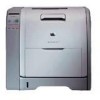HP 3500 HP Color LaserJet 3500 Series Printer - Software Technical Reference, - Page 213
Strategy 3: Use a mix of version‑2 and version‑3 drivers to support all clients
 |
View all HP 3500 manuals
Add to My Manuals
Save this manual to your list of manuals |
Page 213 highlights
printer on .NET using a version-3 driver, and then add the compatible version-2 driver for NT clients, however, as described in Strategy 3. While this strategy has the advantage of simplicity, there are several disadvantages. Because of the restriction for version-2 PCL printer drivers described previously, not all printer products and page description languages can be supported. Another disadvantage of this strategy is the inherent risk associated with running version-2 printer drivers. Finally, at the end of the migration period when all of the clients and servers have been migrated to newer operating systems, the printer drivers being used are all version-2 Windows NT printer drivers; this would definitely lead to further work to upgrade all of the version-2 printer drivers to their version-3 counterparts. Also note that many older version-2 printer drivers cannot be used with this strategy because they are incompatible with Windows 2000, XP, and 2003, and are blocked from installation by those operating systems. Therefore, it is necessary to update existing version-2 printer drivers prior to deploying to migrated servers or clients. Strategy 3: Use a mix of version-2 and version-3 drivers to support all clients In this approach, all of the version-2 and version-3 printer drivers are installed on the print server that are necessary to support a mixed client base during the migration as is illustrated graphically in the following figure. As mentioned previously, these printer drivers must be compatible with one another in such a way that they store the driver configuration in a format that is common to both drivers. HP has compatible printer driver pairs available for most printers and page description languages, as described in the following tables. The information in the tables describes the printers and specific printer driver versions that can be installed together on a server in this manner. Figure 83: Using version-2 and version-3 drivers to support a mixed client base Adding version-2 printer drivers for NT 4.0 clients to existing print queues hosted on Windows 2000 or .NET Server is typically accomplished by accessing the Sharing tab on the printers Properties dialog box and clicking on the Additional Drivers button. Adding version-3 drivers for 2000, XP, or 2003 clients to existing print queues hosted on a Windows NT 4.0 Server is possible but requires a special workaround that is contained in the Microsoft Knowledge Base article 263090 at: Software Technical Reference ENWW Print server operating system migration 211















